The Centralization Problem of Blockchain Network Services
Since last year, DeFi has brought Ethereum into a new round of prosperity. A large number of ecological applications have sprung up. Coupled with the rise of NFT, Metaverse, GameFi and other applications, the encrypted world has become more and more prosperous. A large number of decentralized applications DApps have attracted countless User experience. However, behind the popular application DApp, which is highly sought after by everyone, there are hidden risks brought about by blockchain centralized facilities.
At the end of 2020, the API of Infura, which provides underlying data services for Ethereum, suddenly failed. This incident caused a large number of Ethereum users to be unable to transfer tokens, and popular applications such as Uniswap were also unavailable. The exchange suspended ETH and ERC20 tokens. Withdraw coins.
The problem of the centralization of the basic data at the bottom of the blockchain has actually existed for a long time. Although the full nodes of most blockchain public chains are called decentralized, they actually run on the cloud servers of Amazon and other network service providers. This itself is also a form of centralization. When people pay attention to the application level such as Web3.0, in fact, the centralization of the infrastructure of Web3.0 has become quite prominent, and now it is also facing severe challenges.
How Pocket Network Can Replace Infura
Although the adverse effects of the Infura failure have fully exposed the current problems in the underlying node data of Ethereum, it is a helpless choice for DApp developers to rely more and more on these middleware service providers. As the applications on the Ethereum chain become more and more abundant, the size of the full node of the Ethereum is getting larger and larger, which makes it difficult for most people to run the full node, and there is no incentive to attract people to run the full node.
Although developers may get rid of centralized node service providers such as Infura by running full nodes themselves to provide data support for applications, this will increase operating and maintenance costs on the one hand, and reduce efficiency on the other. For developers, they will naturally choose Infura to provide basic data services, mainly because of convenience. As a result, a large number of DApp developers have given up building full-node services by themselves and rely on centralized blockchain foundations such as Infura Data service organization, which leads to a possible single point of failure, and Pocket Network perfectly avoids such problems, and successfully builds a decentralized blockchain basic service network to ensure the stable operation of upper-layer applications.
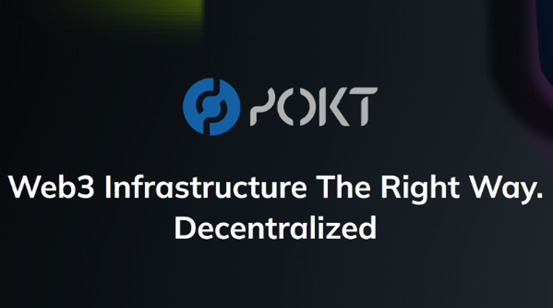 Pocket Network provides RPC relay services for these application builders by providing a unified API. For example, in MetaMask wallets, DApp applications, etc., various blockchain basic data applications request data through the API of Pocket Network to obtain blockchain foundation Data, Pocket Network transmits the request to the entire network nodes, and at the same time randomly selects nodes for RPC data services, Pocket Network will cross-validate the data, which also ensures the accuracy of the data and the anti-censorship of the network nodes.
Pocket Network provides RPC relay services for these application builders by providing a unified API. For example, in MetaMask wallets, DApp applications, etc., various blockchain basic data applications request data through the API of Pocket Network to obtain blockchain foundation Data, Pocket Network transmits the request to the entire network nodes, and at the same time randomly selects nodes for RPC data services, Pocket Network will cross-validate the data, which also ensures the accuracy of the data and the anti-censorship of the network nodes.
Pocket Network re-decentralizes the basic data nodes of the blockchain through incentives, increases data backup, and reduces data service failures, thereby ensuring the stability of the underlying services of the blockchain data. Pocket Network also provides a unified API interface for various developers, which solves the centralization of blockchain network data from the bottom layer, provides reliable infrastructure for application developers, and ensures the normal operation of blockchain applications.
Advantages of Pocket Network over The Graph
From a certain point of view, The Graph actually provides basic data services for the blockchain network, and also includes functions such as data retrieval, but Pocket Network solves the problem from the perspective of the nodes of the basic blockchain services, and this It's something The Graph can't do.
The Graph allows developers to build APIs (called subgraphs), and anyone can build and publish their own subgraphs through The GraphQL technology. The Graph node continuously scans the changes in the subgraph data, thereby realizing DApp to block Chain basic data such as price, transaction status, etc. are confirmed. At the same time, The Graph provides an open data supply market, and thus establishes a whole set of anti-cheating system. If the supplier is found to be inaccurate in the work, he will be punished accordingly, so as to ensure the accuracy of the data. and the stability of the entire system.
The Graph uses "curators" to score the data quality accordingly, so that the indexer can give priority to using these data suppliers with better data quality. In this process, The Graph can well solve the problems of accuracy and diversity of the basic data market.
The Pocket Network has successfully solved the incentive problem of running nodes from the bottom layer. Similar to The Graph, Pocket Network also has applications, nodes and network layers, but the main problem at present is that most blockchain networks still prefer the bottom nodes. Controlled by centralized companies (such as Infura, etc.). Except for the block generation nodes or mining pool nodes of the blockchain network, which have a certain motivation to spend energy on operating network data, most ordinary application developers or network participants have no motivation to maintain enthusiasm for node operations. Therefore, in the long run , which is bound to have an impact on the decentralization of the bottom layer of the blockchain, and may cause problems similar to Infura again.
For Pocket Network, even if its synchronous nodes participating in the entire network do not have the block incentive function, the data nodes participating in Pocket Network can also obtain POKT token incentives by providing data services for various blockchain applications and DApps , decentralized nodes are critical to the stability of the blockchain.
In addition, Pocket Network uses a session model, which does not rely on nodes like The Graph that store index data. Pocket Network provides session information to applications that are connected to it, and at the same time provides services for relay requests sent by applications, and Store information about the network status of Pocket Network to provide corresponding data services to applications. Security and decentralization are ensured by regularly replacing nodes and providing backups in case a node fails or fails to return any results. This also gives each node an equal chance to participate in the next session for reward opportunities.
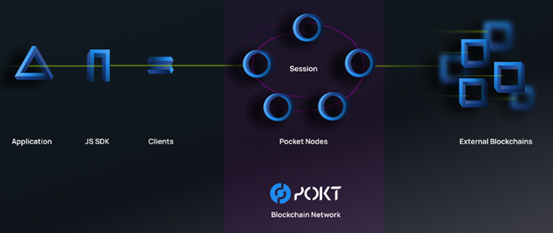 Pocket Network's Token Incentives
Pocket Network's Token Incentives
Pocket Network currently supports multiple mainstream public chains, including Ethereum, Binance, Solana, Algorand, Polygon and other blockchain projects. Through a large number of redundant blockchain nodes, it provides public chain ecological application developers with the underlying area Access service for blockchain data. At the same time, Pocket Network provides a unified development interface, developers can easily switch data between multiple public chains, and the code maintenance is also reduced to a minimum, ensuring the stable operation of developers' applications.
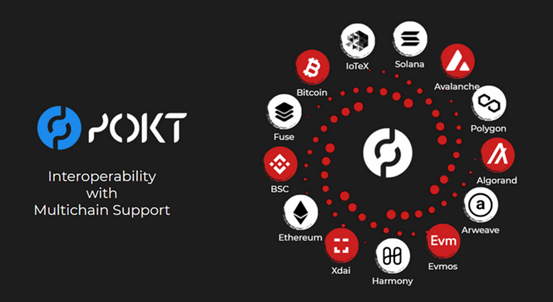 In Pocket Network, each node network and application developers who use Pocket Network data services need to pledge a certain amount of POKT tokens. The tokens pledged by nodes are mainly to ensure the stability of nodes in providing data services and not doing evil. Once the operating node sends invalid data or continues to crash, it will be punished accordingly.
In Pocket Network, each node network and application developers who use Pocket Network data services need to pledge a certain amount of POKT tokens. The tokens pledged by nodes are mainly to ensure the stability of nodes in providing data services and not doing evil. Once the operating node sends invalid data or continues to crash, it will be punished accordingly.
Current status of Pocket Network
The goal of Pocket Network is to adopt the way of DAO operation. Although the development team is mainly responsible for the development of the project, the community is still an important way to participate in the project. Pocket Network also includes a series of node operators and investment institutions. The Pocket Network team started contract writing in 2017. After several years of development, the Pocket Network was officially launched on July 28, 2020, and a total of $9.3 million in tokens was released in January 2021. Sales, strategic investors include blockchain.com, Eden Block, DACM and more than 200 other node operators.
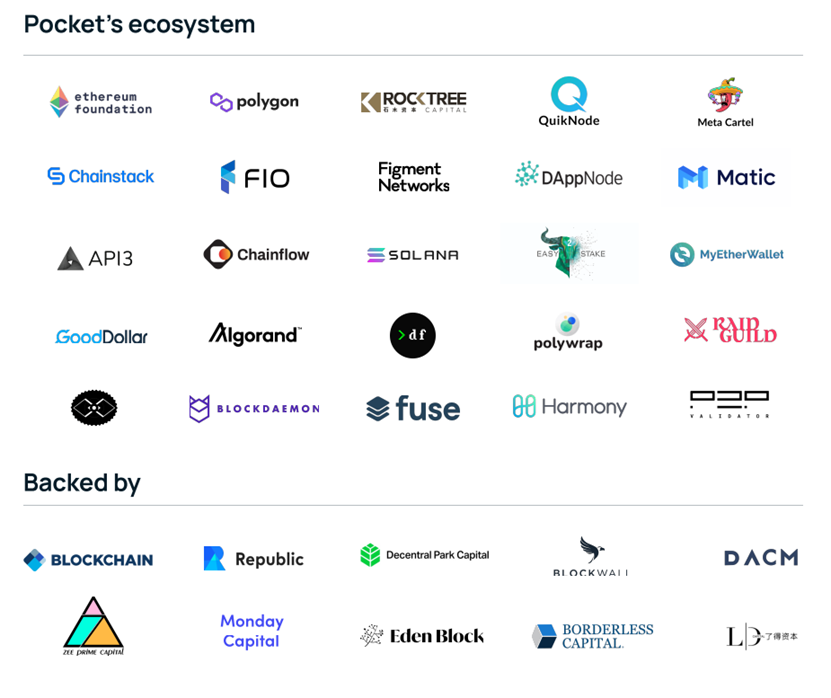
At present, Pocket Network has more than 10,000 operating nodes, and the network development is also gradually growing. The number of daily relays once reached a peak of more than 200 million times.
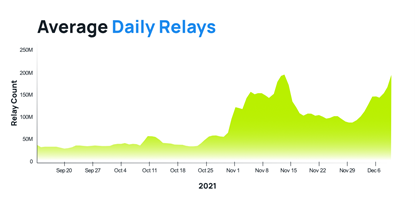
Summarize
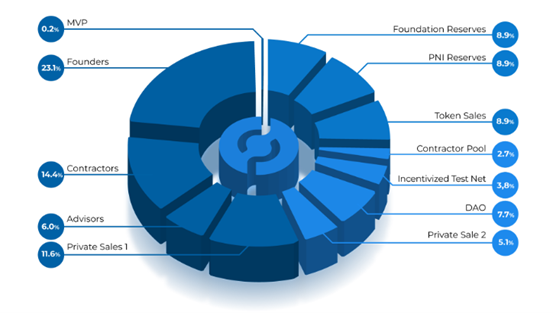 Summarize
Summarize
In summary, the main advantages of Pocket Network are as follows:
1. To protect privacy, service nodes are random and replaced every hour to prevent the data used by application developers from being abused
2. You only need to pledge a certain amount of POKT to enjoy the corresponding amount of free relay. Currently, Pocket Portal offers 1 million daily free relays for migrating dApps. If the free quota is not enough, you only need to pledge another 8,000 POKT to enjoy 1 million free relay services per day.
3. Anti-risk, providing multiple full nodes to provide relays for dApps at the same time, and multiple full nodes for cross-validation to prevent unexpected failures
4. Support multiple public chain network underlying data services
5. Pocket Network is a DAO-based protocol, which is fundamentally different from blockchain data operators like Infura.
6. All applications have the same priority in the network, the only difference is that they can obtain different numbers of free relays according to the total number of pledged POKT, forming a fair competition network.
Generally speaking, Pocket Network enables node operations to be decentralized through node incentives, and at the same time provides unified API data services for blockchain application developers, and supports multiple mainstream public chains. For the public chain, this is a decentralized transformation of the existing blockchain, which will also greatly improve the reliability of various ecological applications, thereby promoting the normal development of the public chain ecology.